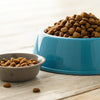Why Dog Won’t Eat Dry Food: Understanding the Reasons and Solutions
- Houndsy
Table of Contents
- Introduction
- Understanding the Basics of Canine Nutrition
- Medical Reasons Your Dog May Not Eat Dry Food
- Behavioral Reasons Behind a Dog’s Refusal to Eat
- Solutions to Encourage Your Dog to Eat Dry Food
- When to Worry
- Conclusion
Introduction
Imagine waking up to find your furry companion staring at their food bowl, sniffing the kibble but refusing to take a bite. As pet owners, this can be an alarming sight, leaving us to wonder, why won’t my dog eat dry food? According to recent studies, up to 30% of dogs may refuse their meals at some point in their lives. This phenomenon can stem from various causes, including health issues, behavioral changes, or simply a dislike for their current food.
In this blog post, we will explore the myriad reasons behind a dog’s refusal to eat dry food, providing insights into potential health concerns, dietary preferences, and behavioral factors. We’ll also delve into practical solutions to encourage your pup to enjoy their meals again. By the end of this post, we aim to equip you with knowledge that not only addresses your immediate concerns but also enhances your daily pet care routine.
We will cover topics ranging from medical reasons and behavioral factors to tips on how to make dry food more appealing. We invite you to reflect on your own pet feeding habits and consider whether any of the insights shared resonate with your experiences. Ultimately, understanding why our dogs may turn their noses up at dry food can help us provide better care and nutrition for them.
Understanding the Basics of Canine Nutrition
Essential Nutrients for Dogs
Before diving into the reasons why your dog may refuse dry food, it’s essential to understand what makes a balanced diet for our canine companions. Dogs require a combination of proteins, carbohydrates, fats, vitamins, and minerals to thrive. Dry dog food, often referred to as kibble, is designed to meet these nutritional needs, but the quality and formulation can vary widely between brands.
- Proteins: Vital for muscle development and repair.
- Carbohydrates: Provide energy and aid digestion.
- Fats: Essential for skin and coat health.
- Vitamins and Minerals: Support overall bodily functions and immune health.
Understanding these components can help us evaluate whether the food we provide meets our dogs' nutritional needs.
Common Types of Dry Dog Food
There are several types of dry dog food, including:
- Standard Kibble: The most common form, usually made from a mix of meat, grains, and vegetables.
- Grain-Free Kibble: Made without grains, often for dogs with allergies or sensitivities.
- Limited Ingredient Diets: Formulated with minimal ingredients to reduce the chance of food sensitivities.
Identifying the type of food your dog eats can offer clues into their preferences and potential issues.
Medical Reasons Your Dog May Not Eat Dry Food
Dental Health Issues
One of the most common medical reasons why dogs refuse dry food is dental problems. If your dog is experiencing pain from tooth decay, gum disease, or a broken tooth, they may avoid dry kibble that requires chewing. Regular dental check-ups and a proper oral care routine are crucial for maintaining your dog’s dental health.
Gastrointestinal Problems
Dogs can suffer from a variety of gastrointestinal issues, including:
- Stomach Upsets: Caused by sudden dietary changes or food intolerances.
- Nausea or Vomiting: Often a sign of an underlying health issue.
- Pancreatitis: A serious condition that can affect a dog's appetite.
If your dog displays signs of discomfort, such as lethargy or unusual behavior, it’s essential to consult your veterinarian.
Systemic Illness
Certain systemic illnesses, including kidney disease, liver problems, and even cancer, can lead to a decreased appetite in dogs. Regular veterinary check-ups can help catch these issues early, allowing for more effective treatment options.
Medication Side Effects
If your dog is on medication, it’s possible that a side effect is impacting their appetite. Always consult your veterinarian if you notice a change in your dog’s eating habits after starting a new medication.
Behavioral Reasons Behind a Dog’s Refusal to Eat
Picky Eaters
Some dogs are simply more discerning about their food choices. They may prefer wet food, human food, or specific flavors. If you’ve been feeding your dog the same kibble for a long time, they may lose interest. Introducing variety—while ensuring nutritional balance—can help re-engage their palate.
Stress and Anxiety
Dogs are sensitive creatures, and changes in their environment can lead to stress and anxiety. Factors such as moving to a new home, the arrival of a new pet, or alterations in their routine can affect their eating habits. Creating a calm and stable environment can help alleviate stress-related feeding issues.
Overfeeding and Treats
If your dog is receiving too many treats or table scraps throughout the day, they may not feel hungry at mealtime. It’s important to ensure that treats make up no more than 10% of their daily caloric intake. A structured feeding schedule can help manage portions and encourage consistent eating habits.
Food Bowl Location
Believe it or not, the location of your dog’s food bowl can impact their willingness to eat. If their bowl is placed in a noisy area or near distractions, they may feel uncomfortable. Ensuring a quiet and peaceful spot for mealtime can make a significant difference.
Solutions to Encourage Your Dog to Eat Dry Food
Make It More Appealing
To entice your dog to eat dry food, consider the following strategies:
- Mix in Wet Food: A spoonful of wet food can enhance the flavor and texture of kibble.
- Warm the Food: Gently warming dry food can enhance its aroma, making it more tempting.
- Add Broth or Water: Mixing in some low-sodium chicken or beef broth can add flavor and moisture, encouraging your dog to eat.
Create a Routine
Dogs thrive on routine, so establishing a consistent feeding schedule can help. Feed your dog at the same times each day, and avoid leaving food out for extended periods. This encourages them to eat during designated meal times.
Consult Your Vet
If your dog continues to refuse dry food, it’s essential to consult your veterinarian. They can rule out any underlying medical issues and provide tailored advice based on your dog’s specific needs.
When to Worry
While occasional changes in eating habits can be normal, there are situations where you should be concerned:
- Persistent Refusal to Eat: If your dog hasn’t eaten for over 24 hours, consult your vet.
- Signs of Illness: Look for symptoms such as vomiting, diarrhea, or lethargy.
- Sudden Changes in Behavior: If your dog is acting unusually, this may indicate a health problem.
Conclusion
Understanding why our dogs may refuse to eat dry food is crucial for their health and well-being. From medical reasons to behavioral factors, there are various aspects to consider when addressing this issue. We must remain observant and proactive in our pet care routines, ensuring our furry friends receive the nutrition they need to thrive.
By implementing the strategies discussed in this post, we can help our dogs enjoy their meals again. If you’re looking for a convenient and stylish way to elevate your dog’s feeding experience, consider exploring the Houndsy Kibble Dispenser. Not only does it provide perfect portion control and enhance your home decor, but it also simplifies the feeding process, ensuring a positive mealtime experience for both you and your pet.
For those interested in transforming their dog’s feeding ritual, we invite you to explore the Houndsy Kibble Dispenser here.
FAQ
Why is my dog suddenly refusing to eat dry food?
Sudden changes in appetite can be attributed to various factors, including dental issues, gastrointestinal problems, or stress. It's essential to monitor your dog for other symptoms and consult your veterinarian if the refusal persists.
Can I mix wet food with dry food?
Yes, mixing wet food with dry kibble can enhance the flavor and texture, making it more appealing to your dog. Just ensure that the combination maintains a balanced diet.
How long can a dog go without eating?
While dogs can survive for several days without food, it’s crucial to monitor their health. If your dog hasn’t eaten in over 24 hours, consult your veterinarian.
What should I do if my dog won’t eat but is acting normally?
If your dog is not eating but shows no other signs of illness, try offering a different food or enhancing the current food's flavor. However, if the behavior persists, it’s best to seek veterinary advice.
Is it normal for dogs to be picky eaters?
Yes, some dogs are naturally more selective about their food. Understanding their preferences and introducing variety can help in managing their eating habits.












